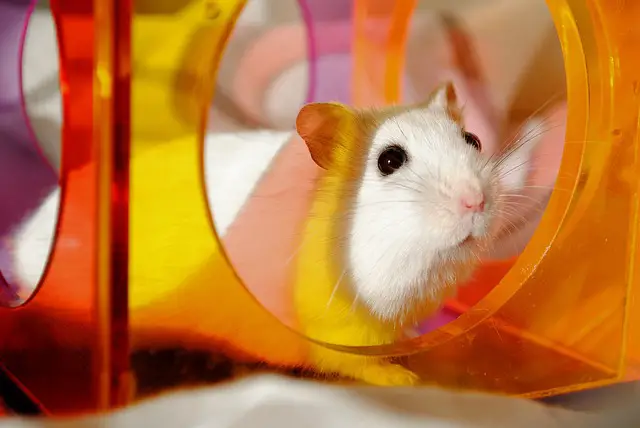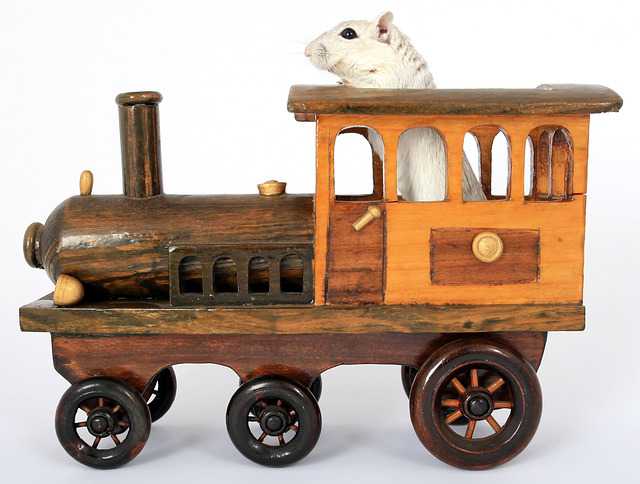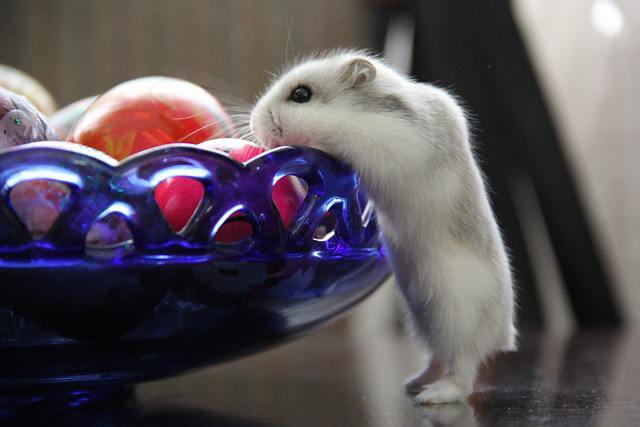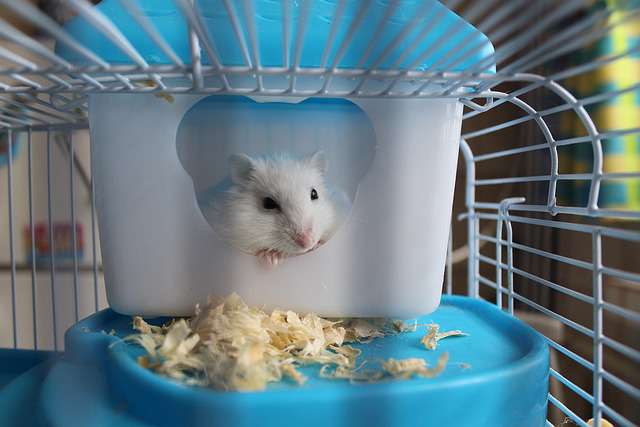Hamster Exercise Needs & Activities You Should Know

Hey there, fellow hamster enthusiasts! Are you tired of seeing your furry friend lazing around all day, just munching on his favorite treats? Well, fret no more!
In today’s blog post, we’re going to dive deep into the world of hamster exercise and explore some fun and creative ways to keep your little buddy active and healthy.
Let’s get started…
Types of Exercises for Hamsters

The following are some types of exercise for your hamster:
1. Running on a Hamster Wheel: A running wheel is an absolute must-have for hamsters. Choose a solid-surface wheel to avoid any injuries to their tiny paws and tails. Syrian hamsters, for instance, require a wheel with a diameter of about 8 to 12 inches, while dwarf hamsters need a smaller one. Place the wheel in the cage, ensuring its stable and easy to access. This gives them the opportunity to run and expend their energy, promoting physical health and mental well-being.
2. Playing with Hamster Ball: The hamster ball is an exciting way to let your furry friend explore the outside world while remaining safe. Opt for a ball with ventilation holes to ensure proper air circulation. Make sure it’s the appropriate size – not too big to avoid difficulty in movement, and not too small to ensure their comfort. Supervision is key here; let them roam around an obstacle-free space, and always be attentive to their reactions.
3. Running Through Hamster Tunnels and Tubes: Hamsters adore tunnels and tubes, as they mimic their natural burrowing behavior. These can be bought from pet stores or even created at home using cardboard tubes. Make sure the diameter is large enough for them to comfortably pass through. Arrange these tunnels creatively in their cage, providing them with hiding spots and avenues for exploration.
4. Climbing Hamster Structures: Adding climbing elements such as ladders, platforms, and bridges caters to their climbing instincts. Natural wood options are preferable, as they also serve as great chew toys, keeping their teeth in check. Ensure these structures are securely fastened to prevent any accidents. These elements stimulate their muscles and engage them mentally as they navigate through the structures.
5. Playing in a Hamster Playground: Creating a miniature playground is a fantastic way to offer a variety of exercises. Utilize items such as cardboard boxes, paper towel rolls, and wooden blocks to construct an enticing play area within their enclosure. Vary the arrangement periodically to maintain their interest and curiosity.
6. Hamster Digging Box: Hamsters are enthusiastic diggers. A shallow box filled with safe bedding or substrate gives them the chance to exhibit this natural behavior. Hide small treats within the bedding to encourage digging and foraging, enhancing their mental stimulation.
7. Playing with a Hamster Maze: Designing a maze out of cardboard or plastic provides cognitive exercise. It taps into their problem-solving skills and spatial awareness. You can create twists, turns, dead-ends, and intersections to challenge their intellect while keeping them physically active.
8. Swinging Perches: Installing small wooden platforms or swings from the cage ceiling adds an element of balance to their routine. This exercise is not only physically engaging, but also amusing to watch. Make sure these perches are secure and stable to prevent any falls.
9. Obstacle Course: Combining various exercise elements to create an obstacle course injects an extra dose of excitement. Utilize tunnels, ramps, climbing structures, and other items to craft a multifaceted challenge. This helps prevent monotony and keeps them mentally sharp.
10. Free-Roaming Time: Giving your hamster some supervised free-roaming time outside of its enclosure is an excellent form of exercise. Ensure the area is safe and free from any potential hazards. You can create a secure playpen or use a hamster-proofed room for this purpose. During free-roaming time, your hamster can explore, run, and play, which provides both physical and mental stimulation.
11. Hamster Treadmill: These miniature treadmills offer a unique form of exercise for hamsters. They can walk or run on the treadmill’s surface, providing low-impact cardio. Introduce the treadmill gradually and ensure your hamster’s comfort. It’s essential to supervise them during their treadmill sessions.
Hamster Exercise Needs

Hamsters have specific exercise needs that are essential for their physical and mental well-being. They require a minimum of one hour of exercise outside of their cage daily to stay healthy.
Providing them with a hamster wheel or a running ball in their cage allows them to engage in physical activity even when they are confined.
Additionally, setting up a hamster playpen or using hamster-safe toys and tunnels can offer them opportunities for exploration and exercise.
Regular exercise not only helps hamsters maintain a healthy weight, but it also prevents boredom and promotes their overall happiness.
Learn more about how to care for your hamster.
Benefits of Exercise for Hamsters
Exercising is important for hamsters to maintain their physical and mental well-being. Here are some major benefits of exercise for hamsters:
- Physical Fitness: Regular exercise helps hamsters stay physically fit. It promotes healthy muscle development, improves coordination, and enhances overall strength and agility. Exercise also helps prevent obesity, which can lead to various health issues in hamsters.
- Mental Stimulation: Exercise provides mental stimulation for hamsters, keeping them mentally active and engaged. It helps prevent boredom and can contribute to a happier and more contented pet. Providing opportunities for physical activity can help reduce stress and anxiety in hamsters.
- Cardiovascular Health: Exercise helps keep the cardiovascular system of hamsters in good condition. It promotes healthy blood circulation, strengthens the heart, and improves respiratory function. Regular exercise can help prevent cardiovascular diseases in hamsters.
- Weight Management: Exercise plays a crucial role in weight management for hamsters. It helps burn calories and maintain a healthy body weight. Regular physical activity, combined with a balanced diet, can prevent obesity and related health problems, such as diabetes and joint issues.
- Muscle Tone: Exercise helps hamsters develop and maintain proper muscle tone. It strengthens their muscles, improving their ability to move and explore their environment. Good muscle tone is essential for overall mobility and physical well-being.
- Enrichment and Bonding: Exercise provides an opportunity for hamsters to explore and interact with their surroundings. It offers mental and sensory stimulation, allowing them to engage their natural instincts. Additionally, exercising with your hamster can strengthen the bond between you and your pet, promoting trust and companionship.
Remember to provide a safe and suitable exercise environment for your hamster, with appropriate toys, wheels, tunnels, and play areas. It’s important to supervise your hamster during exercise to ensure their safety and well-being.
Learn more about simple hamster enrichment.
Hamster-Friendly Exercise Equipment

Hamsters are energetic and active animals that require regular exercise to stay healthy and happy. Providing them with hamster-friendly exercise equipment is essential to ensure they get the physical activity they need. Here are five major and best hamster-friendly exercise equipment options:
1. Hamster Wheels
Hamster wheels are perhaps the most common and popular exercise equipment for hamsters. These wheels allow hamsters to run and exercise in a safe and controlled environment. Look for wheels that are solid and free from any gaps or openings, as these can potentially cause injury to your hamster. It’s important to choose a wheel that is appropriately sized for your hamster to ensure comfortable and safe exercise.
2. Hamster Balls
Hamster balls are another popular choice for providing exercise to hamsters. These clear plastic balls allow hamsters to explore their surroundings while being safely contained. Hamster balls are great for providing mental stimulation as well as physical exercise. Ensure that the ball is properly ventilated and large enough for your hamster to move around comfortably.
3. Hamster Tunnels and Tubes
Hamster tunnels and tubes are a fun way to encourage exercise and exploration for hamsters. These can be standalone units or attached to the cage, providing hamsters with a network of tunnels to navigate. Tunnels and tubes can be made of plastic or other hamster-safe materials and can be arranged in various configurations to keep your hamster engaged and active.
4. Hamster Climbing Structures
Hamster climbing structures offer vertical exercise opportunities for your hamster. These structures can include ladders, ramps, and platforms that allow hamsters to climb, jump, and explore. Look for climbing structures made of sturdy materials and ensure that they are securely attached to the cage to prevent accidents.
5. Hamster Playgrounds
Hamster playgrounds are larger setups that provide a variety of exercise options for hamsters. These can include multiple levels, tunnels, climbing structures, and interactive toys. Hamster playgrounds are a great way to create an enriched environment for your pet, promoting exercise, exploration, and mental stimulation.
When choosing hamster exercise equipment, always prioritize safety and suitability for your hamster’s size and breed. Ensure that the equipment is made of non-toxic materials and is easy to clean and maintain.
It’s also important to provide a variety of exercise options to keep your hamster entertained and engaged. Regularly inspect the equipment for any signs of wear and tear and replace or repair as needed to ensure the safety of your hamster during exercise.
Learn more about hamster socializing and taming.
Hamster exercise mistakes to avoid
The following are some common hamster exercise mistakes to avoid:
1. Lack of supervision: Leaving your hamster unattended during exercise can be risky. Hamsters are small and agile creatures that can quickly escape or get into trouble. Always supervise your hamster closely, especially during free-roaming playtime outside of their cage.
2. Inadequate space: Hamsters love to explore and run around, so it’s crucial to provide them with enough space to exercise. Avoid confining your hamster to a small enclosure or exercise wheel that is too small for them to move comfortably. Opt for a spacious cage or use a hamster ball or playpen to give them room to roam.
3. Improper exercise equipment: Using the wrong exercise equipment can lead to injuries or accidents. Avoid exercise wheels with large gaps or exposed metal parts that may trap your hamster’s feet or tail. Choose a wheel that is appropriate for your hamster’s size and has a solid running surface.
4. Overexertion: While it’s important for hamsters to get regular exercise, overexertion can be harmful. Avoid forcing your hamster to exercise for extended periods or pushing them beyond their limits. Provide short and frequent exercise sessions to prevent exhaustion.
5. Neglecting mental stimulation: Physical exercise is essential, but mental stimulation is equally important for a hamster’s well-being. Avoid solely focusing on physical activities and incorporate toys, puzzles, and tunnels in their cage to keep them mentally stimulated and entertained.
Learn more about hamster accessories to get.
Related Questions
How much exercise do hamsters need?
Hamsters are active creatures that require regular exercise to stay healthy and happy. It is recommended that they have at least an hour of supervised exercise outside of their cage each day. This can be achieved through activities such as running on a hamster wheel, exploring a playpen, or using hamster tunnels.
Can hamsters exercise in their cages?
While hamsters do need time outside of their cages for exercise, it is also important to provide them with opportunities for physical activity within their enclosure. A spacious cage with multiple levels, exercise wheels, and tunnels can provide a stimulating environment for your hamster to stay active even when they are confined.
What are some signs that my hamster needs more exercise?
If your hamster seems restless, bored or exhibits excessive chewing, it may be a sign that they need more exercise. Hamsters are curious creatures and need mental and physical stimulation to prevent them from becoming stressed or agitated. Providing them with a variety of toys, tunnels, and opportunities for exploration can help fulfill their exercise needs.
Are there any specific exercises that are good for hamsters?
Hamsters are natural runners and love to use exercise wheels. Providing them with a solid, appropriately sized wheel will not only provide physical activity but also mental stimulation. Additionally, setting up a hamster obstacle course with tunnels, ramps, and bridges can be a fun way to encourage exercise and keep your furry friend entertained.
How can I ensure my hamster exercises safely?
When allowing your hamster to exercise outside of their cage, it is important to create a safe environment. Remove any potential hazards such as electrical cords, toxic plants, or small objects that your hamster could swallow. Supervise their exercise time to prevent them from escaping or getting injured, and always handle them gently and with care.
Can hamsters exercise with other pets?
It is generally not recommended to let hamsters exercise with other pets, especially cats or dogs. They may view your hamster as prey or become overly excited, which can lead to accidents or injuries. It is best to keep your hamster’s exercise time separate from other pets to ensure their safety and well-being.
Learn more about creating a safe hamster habitat.
Conclusion
In conclusion, it’s clear that exercise is essential for our furry friends, the hamsters! Whether it’s running on their wheels or exploring a hamster playpen, staying active is crucial for their physical and mental well-being.
So, let’s make sure our hamsters get their daily dose of exercise to keep them happy, healthy, and full of energy!
